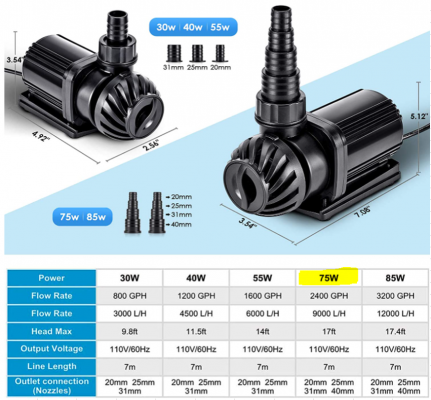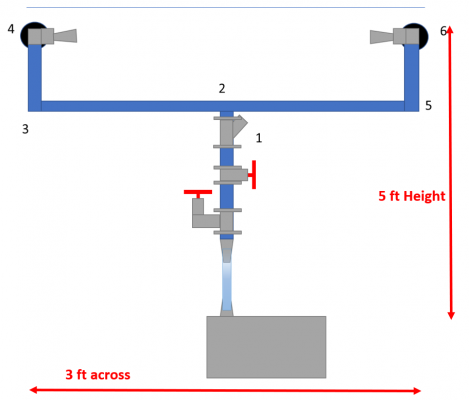Display Tank is a 40 Gal Breeder with a 20 Gal Long Sump underneath
Return Pump is a AQQA 75W Pump with the following stats: flow rate of 2400 gph at 0 head and a max head of 17 ft
Return plumbing will be 1" return line with dual returns and an estimated 5ft head height with an extra 6ft head height for fittings which gives 11 ft total head.
At a 11ft head, Pump rate velocity drops to: 900 gph Total or 450 gph at each of the 2 returns
My question then becomes what is the optimal size and number of VCA RFG's required to best support this Mixed Reef Tank?
A. Go with two 3/4" RFGs: cheapest solution but creates additional pipe friction due to reduction down from 1" to 3/4" with increased flow velocity. (Are the RFG's still at optimal flow range at 900 gph total flow even though each RFG is only getting 1/2 of that at 450 gph?)
B. Go with two 1" RFGs: I feel this may be overkill for a 40 gal Breeder, and likely me puts outside of the optimal flow range per VCA, but you get no pipe ID reduction with its associated pipe friction on the return plumbing
C. Go with a single 1" return and use one 1" RFG on a sea swirl: Most expensive and probably not as clean looking as a drilled return
D. Go with a single return and use two 3/4" RFG wyed on a sea swirl. Most Expensive, and maybe not pretty plus Additional pipe friction due to reduction but you get maximum random flow spread across the tank
Last question: is it better to orient the RFGs along the length of the tank for maximum penetration in the water column or along the tank side with less penetration before the flows smacks up against the glass?
Thanks in advance



Return Pump is a AQQA 75W Pump with the following stats: flow rate of 2400 gph at 0 head and a max head of 17 ft
Return plumbing will be 1" return line with dual returns and an estimated 5ft head height with an extra 6ft head height for fittings which gives 11 ft total head.
At a 11ft head, Pump rate velocity drops to: 900 gph Total or 450 gph at each of the 2 returns
My question then becomes what is the optimal size and number of VCA RFG's required to best support this Mixed Reef Tank?
A. Go with two 3/4" RFGs: cheapest solution but creates additional pipe friction due to reduction down from 1" to 3/4" with increased flow velocity. (Are the RFG's still at optimal flow range at 900 gph total flow even though each RFG is only getting 1/2 of that at 450 gph?)
B. Go with two 1" RFGs: I feel this may be overkill for a 40 gal Breeder, and likely me puts outside of the optimal flow range per VCA, but you get no pipe ID reduction with its associated pipe friction on the return plumbing
C. Go with a single 1" return and use one 1" RFG on a sea swirl: Most expensive and probably not as clean looking as a drilled return
D. Go with a single return and use two 3/4" RFG wyed on a sea swirl. Most Expensive, and maybe not pretty plus Additional pipe friction due to reduction but you get maximum random flow spread across the tank
Last question: is it better to orient the RFGs along the length of the tank for maximum penetration in the water column or along the tank side with less penetration before the flows smacks up against the glass?
Thanks in advance
















